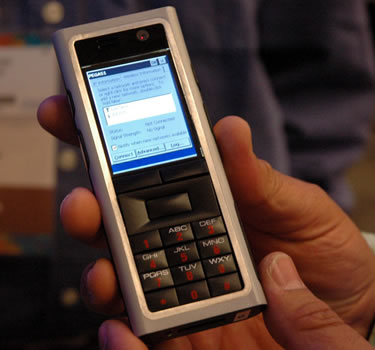Intel senses united wireless future in 802.21

In a pre-show briefing to international press on Monday, Intel discussed developments that the company claims will herald a new era of cooperating standards in wireless. "Our goal is to provide seamless network connectivity across a wide range of networks," said Alan Crouch, the director of Intel's Oregon Communications Technology Lab. "And 802.21 is the one to watch," he added.
One of the latest standards committees, 802.21 is developing protocols that cover both 802-type wireless networks and mobile telephony. "It's really important to set the standards and to implement experimental versions," said Crouch. "We have to define common technology components." The standard will contain ways for mobile devices to analyse the radio environment about them, with different layers in the software providing hints or triggers when it's time to change from Wi-Fi to 3G, for example, he said.
"The goal is to provide seamless network connectivity across a wide range of networks, so users will move from hotspot to cellular connection without noticing. These are hard technical challenges, but we're confident that working with the industry we can find ways to make it happen." Crouch added: "There are some particularly interesting problems to solve in simultaneous operation of multiple radios such as Bluetooth, GPRS, Wi-Fi and GPS, where we need to mitigate radio interference". 802.21 would enable usable models where mobile VoIP and other enterprise applications could be deployed in the field as easily as they were in the office, he said.

A prototype mobile phone that combines four different wireless standards: Bluetooth, GPS, GPRS and Wi-Fi.
However, don't expect the new standard to be in your next mobile phone. "There is no date announced yet for the completion of 802.21," said Crouch. "We're working hard to move through the standards process, but it will move like the IEEE moves."
Mote points
In other wireless-related news, Intel said that it was winding down some basic research into sensor networks at Intel Research Berkeley because "it had been successful", transferring the work to a new division under principal researcher Ralph Kling. "We're not quite ready to roll out products," said Kling, "but we're perhaps close to pre-production". Motes — tiny self-powered packages containing processors, sensors and wireless — are designed to form self-configuring networks and provide data about an area or a physical system. "Our first market will be industrial," Kling told ZDNet UK. "Because of their low power and ability to run for a long time on batteries, motes are particularly suited to hazardous areas where intrinsically safe wiring is expensive and complicated."
An Intel Mote, showing how options can be stacked on nesting boards.
The Berkeley research had shown how motes could be most efficiently configured, he said, with some acting as relays to other networks while others provided local infrastructure. "Traffic accumulator motes called Stargates can be powered externally, leaving the low power motes to collect data," he said. Intel had used motes to monitor its own chip fabrication plants, he added.
Kling demonstrated the latest device, Intel Mote 2, which combined an XScale 'Bulverde' PXA 271 processor with DSP, 32MB apiece of RAM as well as flash memory and a multi-radio architecture that supports 802.15.4, Bluetooth and 802.11 through optional modules. "This is very close to the sort of system that will be productised [sic]," he said. "It has the sort of power needed to do real-world tasks."